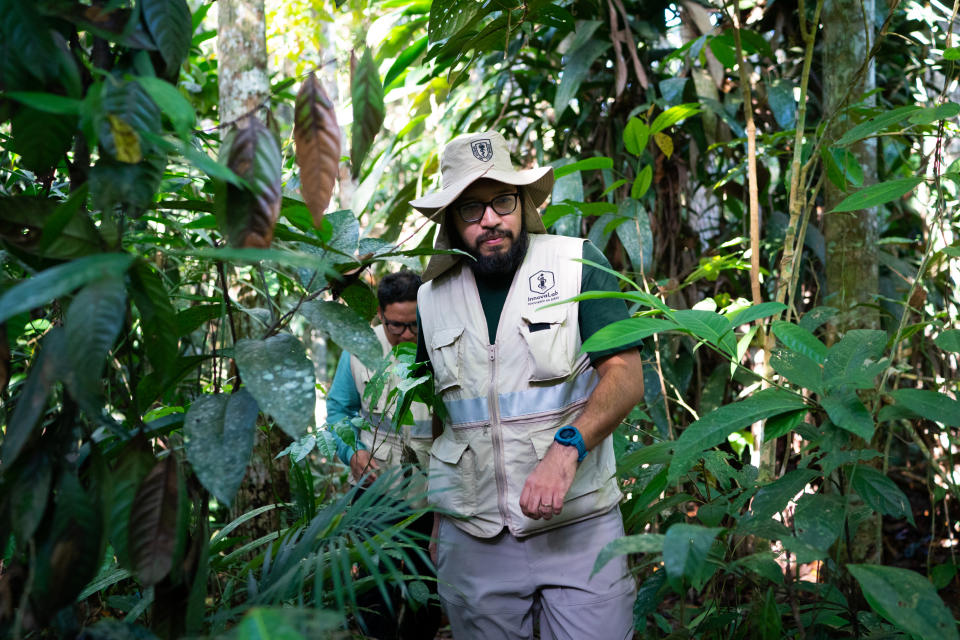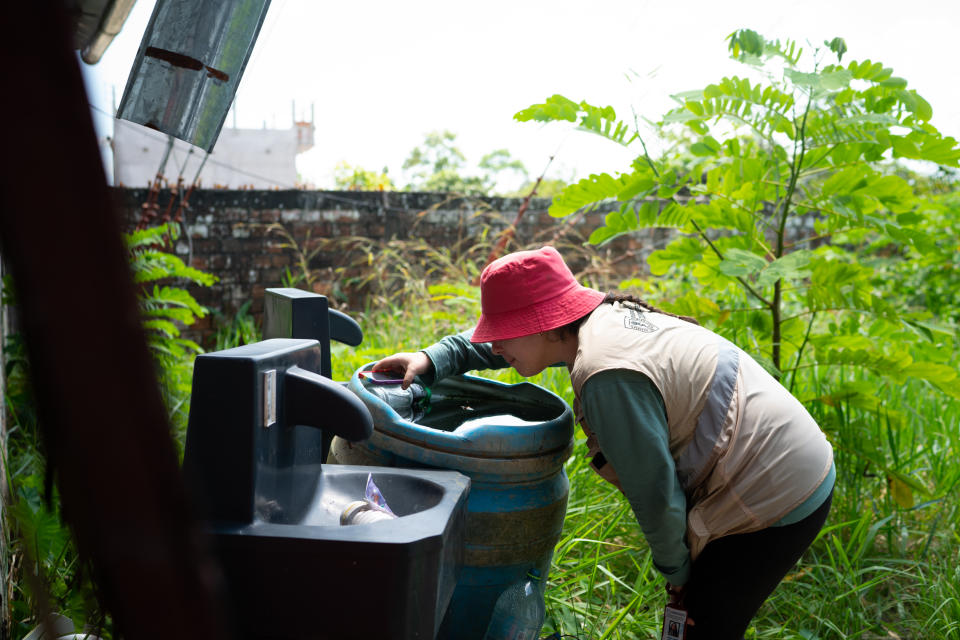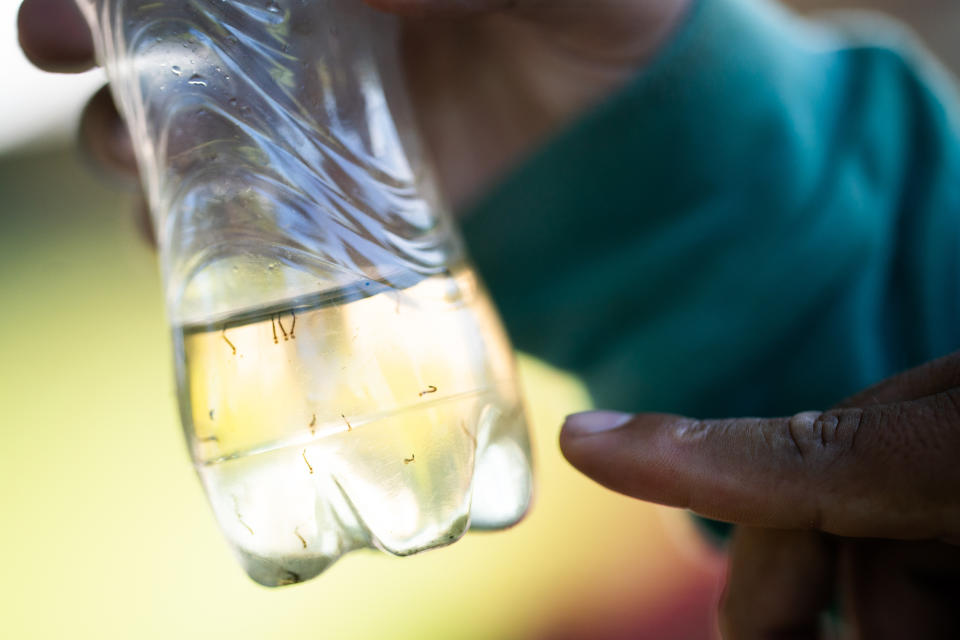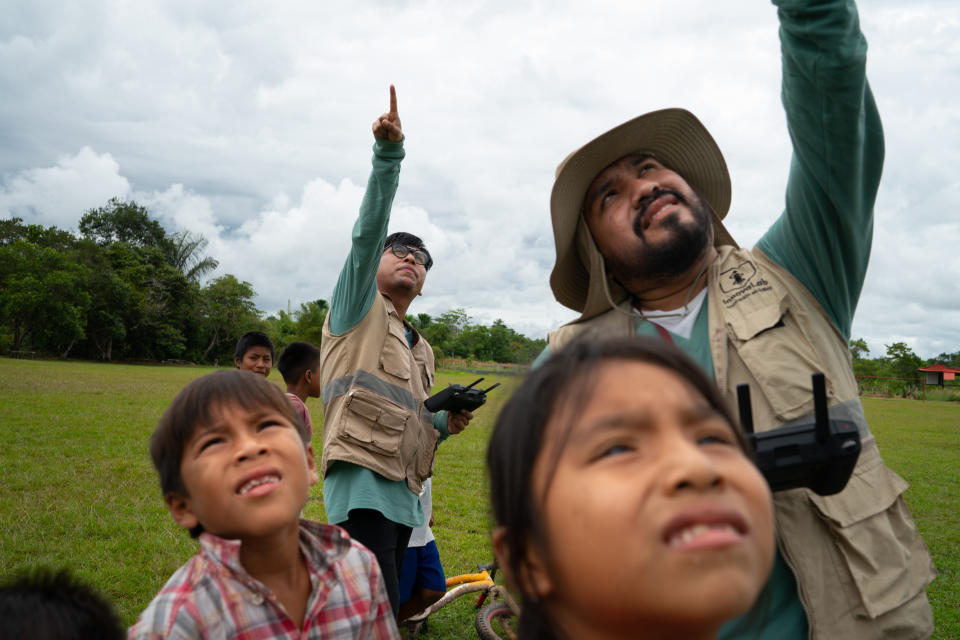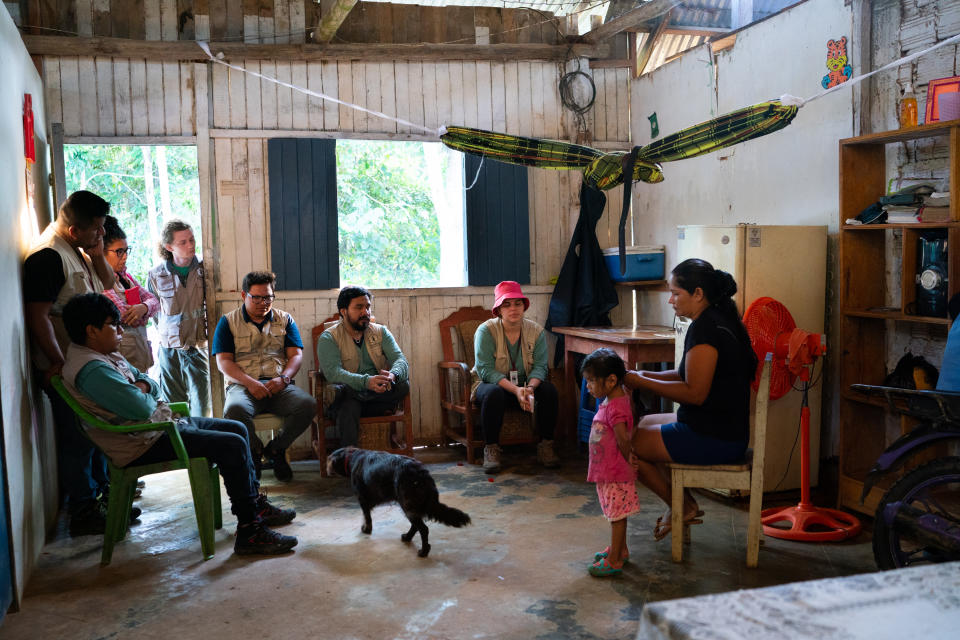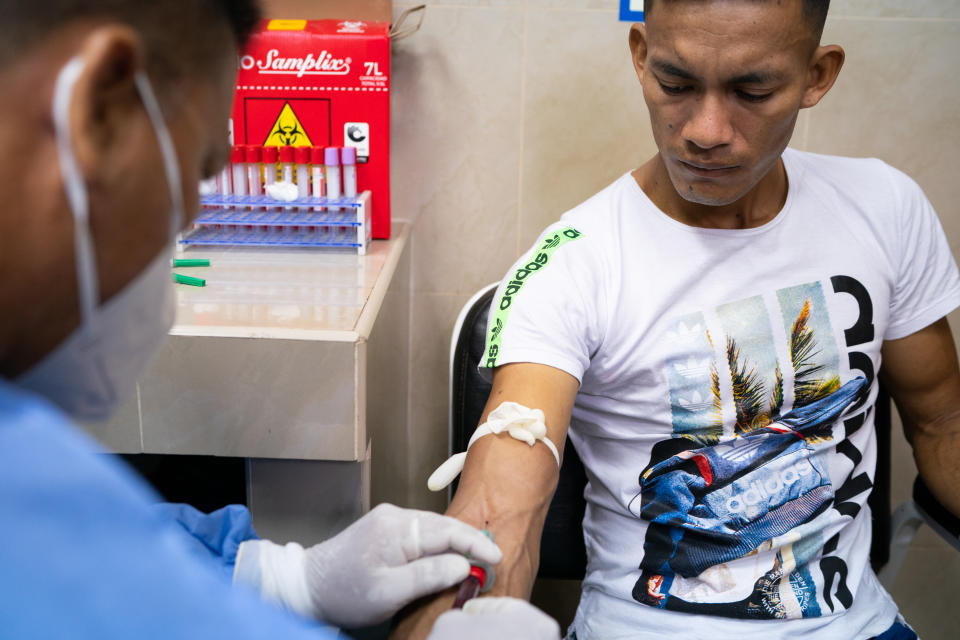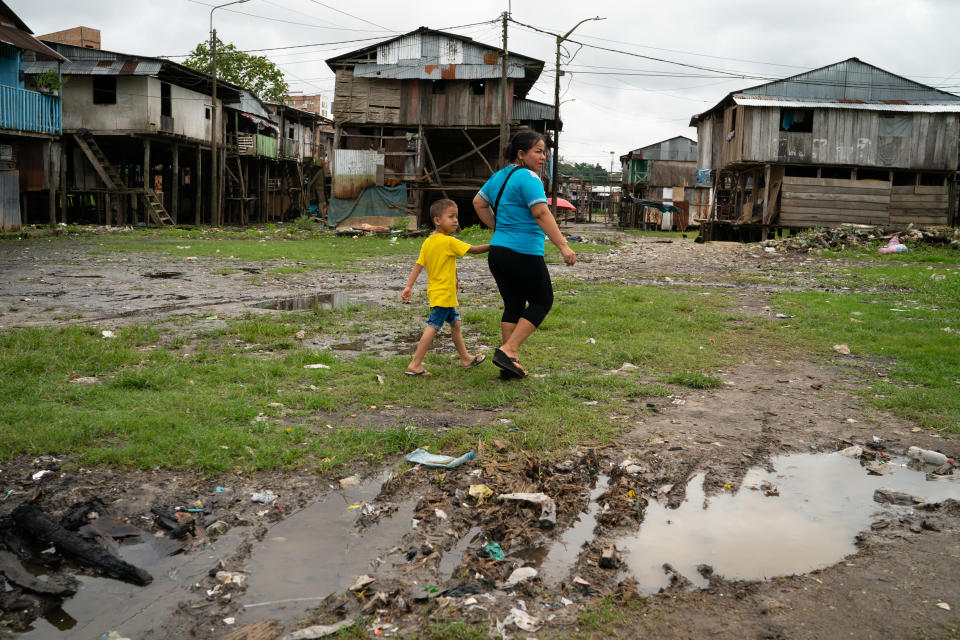Hunting climate disease: As outbreaks brew, can scientists stay a step ahead?
CAHUIDE, Peru - Aedes, a grayish four-propeller drone, whirred off the dirt soccer field in this Amazon village to help do what doctors cannot as climate change threatens this nation with a new era of disease.
Named after the mosquito that transmits dengue fever, it quickly rose above the excited gaggle of flip-flopped kids gathered to see it off and past their homes' corroded metal roofs. Soon, it was nearly 400 feet high, scanning roads cutting into the jungle for new signs of disease-spreading mosquitoes.
"We can't keep fighting dengue, malaria, all diseases with the tools we've had for 40 or 50 years," said Gabriel Carrasco, the 32-year-old epidemiologist who deployed the drone. "We're at the gateway of the consequences of climate change."
This year, Peru suffered its worst outbreak of dengue in recorded history - a plague that some researchers say could be linked to record-breaking temperatures and precipitation driven by climate change. More than 250,000 people got infected and at least 430 died of the illness, which attacks the joints.
Dengue is one of several diseases appearing in more places and in higher numbers, overwhelming the country's ability to predict outbreaks and contain transmission. Cases of leptospirosis - a bacterial disease spread by the infected urine of rats and other animals - also have risen in parts of Peru.
Carrasco and other researchers are among the scientists who warn that this new age of climate-fueled disease requires a far more sophisticated response, as medical authorities rely on incomplete and outdated case records to try to prepare for and react to outbreaks.
Besides Aedes, Carrasco has hauled dozens of pieces of high-tech gear hundreds of miles from his lab in Peru's capital, Lima, to communities that have sprouted along a highway running along the Amazon River. Harnessing these drones and sensors, he aims to produce highly detailed maps of where disease is moving as new weather patterns emerge, and then feed that information into an artificial-intelligence program that could better predict when and where outbreaks will erupt among threadbare communities that have little capacity to protect themselves.
To predict the spread of dengue, Carrasco and his team are flying drones to monitor several communities deep in the Amazon jungle in the northeast of Peru.
Using a combination of photos they've captured with drones and on field trips, the researchers map sites where the Aedes aegypti mosquito is likely to breed.
A broken-down vehicle could also collect rainwater, becoming a potential breeding site.
Even small objects such as this water tank, or plastic jugs, are flagged to detect where the mosquitoes might move next.
Scientists can now easily trace how humanity's carbon dioxide emissions are fueling hurricanes and wildfires. But here in Peru and around the world, researchers are racing to decipher how disease behaves on a warming planet.
In California's Central Valley, scientists are using drones to detect the fungus spreading Valley fever. City officials in Ahmedabad, India, have developed a heat emergency plan that features an early-warning system and community outreach when temperatures spike. In Ethiopia, experts are working to tie weather data from satellites and artificial-intelligence models into the country's malaria surveillance program to help public health officials prepare for outbreaks. In Nicaragua, researchers are testing weather apps in sugar cane fields to predict dangerous heat conditions and which workers are most at risk.
Cases of dengue soared this year across Peru, including in dry places where the disease had rarely surfaced. Patients languished under mosquito nets in hospital corridors as the onslaught overwhelmed the country's health-care system.
"There was a delay in diagnosing cases because the doctors weren't prepared," said Theresa Ochoa, who heads the Tropical Medicine Institute Alexander von Humboldt in Lima. "Patients spent days with complications because of that."
For Carrasco, getting ahead of climate-fueled disease is especially urgent in the Amazon, where poor access to health care means residents bear an outsize toll from global warming, even though they barely contribute to it.
"People here are exposed to everything," he said. "There is no barrier between the environment and them. It rains and they get wet. There are fires and they are exposed."
- - -
A climate collision
For decades, health-care workers in this deeply forested region of northeastern Peru bordering Brazil and Colombia could predict who would show up at local clinics, and why. Malaria appeared only in the jungle, while dengue affected city dwellers. Leptospirosis was relatively rare.
But climate change is driving disease in unexpected ways - through extreme swings in weather as well as shifts in where people can find food and work.
Hotter temperatures and wetter weather are making it easier for mosquitoes - which spread both dengue and malaria - to thrive. Aedes aegypti, the mosquito that transmits dengue, does best when temperatures are close to 84 degrees Fahrenheit, though it can spread the disease within a much broader temperature range.
In recent years, temperatures in Peru have been climbing. Over the past decade, Lima experienced an average of 86 days per year between 72 and 86 degrees Fahrenheit, compared with 78 days per year in the previous 10-year period. In 2023, there have already been 139 days with an average temperature in that window.
Dengue cases in the capital region spiked to more than 30,000 this year, compared with fewer than 1,000 in 2022.
Peru is not alone: Bangladesh also has experienced its most severe dengue fever outbreak on record this year. A World Health Organization report attributed the uptick to "excessive rainfall, waterlogging, flooding, rise in temperature and the unusual shifts in the country's traditional seasons."
As more places get closer to the insects' sweet spot and as people are exposed to mosquitoes for longer periods, the chances of contracting dengue multiply. The expected number of Peruvians who can get infected from a single case in places primed for dengue - because of the changing climate and how humans are creating a more favorable environment for mosquitoes to proliferate - has nearly doubled since the 1950s, according to the Lancet Countdown, a global group of health researchers.
As climate change makes Peru more welcoming to mosquitoes, it's also pushing humans into the kind of communities where they're more likely to get infected: informal settlements with no running water or regular trash service, like the ones Carrasco is studying.
Andrés G. "Willy" Lescano, who heads a center focused on climate change and health at Peru's Cayetano Heredia University and collaborates with the Lancet Countdown, said these haphazard developments leave people exposed.
"Given that temperatures are rising because of climate change and more extreme weather events, that's making the population more vulnerable because they live in chaotic cities that have grown without any planning," he said.
The Amazon rainforest covers most of Peru's eastern half. Cut off from the rest of the country by the Andes, this region is sparsely populated, with most people clustering around a few cities and a growing number of shantytowns carved out of the jungle.
Indigenous people have been congregating in these newer, more tightly packed communities for decades, lured out of the deepest parts of the rainforest by jobs and schooling for their children. But climate change is giving them more reasons to leave their relatively isolated homes for these more crowded settings. Over the past few decades, parts of the Amazon have seesawed between more intense drought and floods fueled by warming temperatures in the Pacific and the Atlantic, which scientists have linked to climate change. The frequency of floods has gone up from one every 20 years from 1900 to 1950 to one roughly every four years starting in the 2000s, one study found.
This more extreme weather is making it harder for people to eke out a living from rivers and small farming plots in the jungle, forcing them to move.
"People who depend on this food system, if they can't make it work, they're going to leave," said Carol Zavaleta, a doctor affiliated with Cayetano Heredia University who studies health and nutrition in the Amazon.
The places where they are settling provide dengue-carrying mosquitoes, no strangers to the Amazon, a wider choice of places to breed: supine doorless refrigerators that serve as open-air cisterns, the standard plastic tub to wash clothes, myriad crumpled plastic bottles whose nooks and crannies become cozy egg depositories when filled with even the tiniest amount of water. These containers can host mosquitoes whether storms are topping them off or people are storing water in them during times of drought.
Over the past few years, summers in Iquitos, the biggest city in the area, have been hotter and drier, and have stretched for longer periods. Outbreaks of dengue, meanwhile, have been more severe.
These new settlements are also fueling the spread of malaria, which is transmitted by a different mosquito, Anopheles darlingi. Unlike Aedes, it prefers bigger bodies of water to lay its eggs, but those are multiplying because of humans, too. When new residents fell trees to make space for additional homes, fields and roads, they alter the terrain and block streams, creating ponds. Wells and fish farms, which also tend to pop up in these communities, offer Anopheles other suitable breeding sites. Combined with warmer temperatures, these environments can lead to higher malaria rates.
By 2070, the length of the transmission season for malaria could expand by up to five months in some parts of the country, particularly in middle-elevation areas on the edges of the Amazon Basin, according to a Washington Post analysis of projected climate data.
Flooding can turn these communities into hotbeds of leptospirosis, too, as heavy rains flush out trash and infected rats. The contaminated water can linger for days, sometimes standing waist-deep, making it unavoidable for residents and causing a spike in cases.
For doctors facing the climate-change-induced onslaught of these three diseases, which share fever as a key symptom, telling them apart is becoming more difficult. "There was a time when I could tell if a person had dengue or malaria just based on where they came from," said César Ramal, the head of infectious diseases at the regional hospital. "I can't do that anymore."
The ability to track ailments based on historical patterns helped doctors keep on top of not only individual patients' treatment, but also the health of the broader community. They could prepare public-awareness campaigns ahead of the dengue season, for example, or stock up on malaria treatments in the places where it usually popped up.
Now, the changes resulting from these new patterns are coming too quickly for the country's systems to keep up.
Local clinics, which don't have the tools to do complex lab work, often have to wait days to get tests back from a regional lab for analysis. To lessen labs' load, doctors test only the sickest and most vulnerable patients. In the meantime, more people can become sick, potentially creating bottlenecks for the whole health-care system.
In May, crowds of feverish patients who showed up at the emergency room of a regional clinic near Iquitos had to wait to be diagnosed, said Camila Carrera, the only doctor on duty that day.
During that month, clinics in the region formally diagnosed fewer than half of the patients who displayed dengue symptoms, according to official records.
"In the emergency room we don't have time to investigate," Carrera said.
Even outside emergency rooms, public health officials have just rudimentary resources to track disease.
At the health center in Belén, a shantytown at the edge of Iquitos, staff epidemiologist Silvia Guerra uses thumbtacks to pin new cases on a wall map. Tiny paper cutouts with a picture of a mosquito denote dengue. For leptospirosis, she uses a rat.
Those thumbtacks represent patients who were ill enough to miss work, which means many others who were mildly sick, but still able to transmit diseases, go undetected, Guerra said.
Without a full picture, it becomes more difficult to spot and prevent disease.
"They have very few resources. They can't cover the whole population or treat all the problems," Carrasco said. "The idea is to optimize those resources."
- - -
A malady report
Carrasco has been tracking disease in this section of the Amazon since he was a college biology student more than a decade ago. While his colleagues searched for its causes by examining bugs and blood under the microscope, he spotted tipoffs in the broader environment.
They were everywhere.
Kids tended cough-inducing wood fires destined to cook hen soup ahead of the busy market day. The unrefrigerated fish and tropical fruit on offer attracted colonies of leptospirosis-carrying rats. Glassless window openings invited dengue-infected mosquitoes.
"Each teenager and adult was almost a statistical miracle," he said. "If you make it to 18, you arrive made a Rambo, a warrior."
Now Carrasco heads InnovaLab, a health innovation lab at Cayetano Heredia University, where he and his team use technology to zoom in on those environmental clues. Understanding these links, he says, is key to detecting - and preventing - climate-induced maladies.
Along with scanning for potential mosquito breeding sites, Aedes and Anopheles, another drone (named after the mosquito that transmits malaria), can identify homes that are prone to flooding - and whose dwellers are at greater risk of stepping into puddles contaminated by rat urine.
In more heavily wooded areas, sound sensors strapped to the thorny trunks of tropical trees can detect the whir of power saws, a potential indicator of new residents who are clearing the forest to build homes. Those newcomers multiply the risks of exposure to dengue-carrying mosquitoes, as they bring more containers in which they can breed. They also create new environments for malaria mosquitoes and increase the chance that they will come into contact with humans on the forest fringes.
In the few weeks between Aedes's regular flights this summer, plots for five new homes materialized out of a previously verdant area in 12 de Abril, one of the communities InnovaLab is studying.
"This town has changed a lot," said Lino Papa, a former town leader. "It was very small, 20 families from the Amazon jungle. Now there are 180."
The researchers are layering the data collected by their gadgets with the information that local health-care workers such as Guerra fill in by hand on case forms. Next, they will deploy artificial intelligence to identify patterns that trigger outbreaks amid the jumble of changes in weather, living conditions and disease.
"In these areas, the swings in weather are big - very rainy days or dry, with a lot of wind," Carrasco said. "Eventually, we're trying to get ahead of events that trigger disease, so when we see them, we can predict the chances of an outbreak happening in the following weeks or months."
It's the beginning of the kind of infrastructure needed to link climate change to health and, eventually, to create a forecasting system similar to what already exists for weather. Depending on evolving conditions, the model could generate malady reports: low chance of leptospirosis in the outskirts of 12 de Abril; high probability of dengue in eastern Cahuide.
"It would be very helpful because suddenly we could identify infection flare-ups in real time," Guerra said. "That would allow me to organize my teams and focus on contaminated areas so that doesn't expand."
Carrasco expects to make the first predictions once his team has collected one year's worth of data, sometime next spring or summer, to include seasonal changes. But he plans to leave the gadgets in the jungle, to keep adding information to hone his model.
- - -
Will it work?
For Carrasco's project to graduate from scientific experiment to permanent disease surveillance system, he needs to persuade health authorities to use it.
While researchers elsewhere are trying to build similar forecasting tools, some experts are skeptical that a model can encompass all the elements that trigger disease at such a granular level. "Our ability to predict what is going to happen in a particular place, this place being a country, a province, or a region - that's very hard," said Lescano, the head of the climate and health center. "There's a convergence of many factors that don't have to do with the climate."
That's why, as they piece together their project, Carrasco and his researchers have been consulting with the regional health agency, known by its Spanish acronym GERESA. On a recent trip to Iquitos, the team crowded around a large table at the agency's hectic headquarters for an update. Over the constant ding of cellphones, Bryan Fernandez, the Anopheles drone's pilot and fieldwork coordinator, showed the staff how to use a new dashboard that overlaps disease cases with weather data.
Bersy Sánchez, head of disease prevention at the agency, was noncommittal. "We'd like to see it farther along to get a better idea," she said.
She'd also like Carrasco to include more of those non-weather-related pieces of the malady puzzle. Would it be possible, Sánchez asked, to determine whether bodies of water have fish? For local residents, a protein-filled diet can be the difference between having strong enough defenses to fight off disease or succumbing to it.
InnovaLab's drones can collect data on water cloudiness to determine whether ponds might be mosquito breeding sites, but accurately spotting fish is beyond them. For that, Carrasco would need a submarine drone, which he wants to buy.
Even if he could afford every item he seeks, data will only go so far in preventing disease in a place where many families don't have enough to eat, or the $5 for a boat ride to the nearest clinic.
And there are other barriers that would probably confound even the most advanced AI. InnovaLab's researchers, most of them based in Lima, have to navigate around the local propensity for supernatural beliefs. Earlier this summer, they faced communities on edge because of reports of strange beings haunting villages during the night. Residents, convinced that the visitors were space aliens, organized armed brigades to patrol the area.
Investigating authorities later said the culprits were probably illegal miners, trying to scare villagers in order to scout for gold in the surrounding forest. But Lucía Bartolini, project manager at InnovaLab, had to stage an emergency public relations intervention so locals did not confuse the team's drones with UFOs. Aedes and Anopheles, she assured community leaders, fly only during the day. The day the team launched the drones from the soccer field, Bartolini handed out bagged chips for the town's children. Fernandez let them hold the drone controls.
Slowly, some locals are embracing the project. "I consider myself having an education a bit superior to local residents, but, honestly, I can't make head or tail of it," said Jaime Canelo, the leader in another community, Llanchama. "But I know it's very valuable."
For Carrasco, his audience goes beyond public health officials and local leaders. He also wants to inspire his team of young researchers to reimagine a public health system unfit to handle the pressures of climate change.
"Every time we travel, we see these places where people don't have very high chances of survival," he said. "There is always this reflection of what to do to increase those chances by even 1 percent."
- - -
Ian Livingston and Kevin Crowe contributed to this report.
Related Content
Her story fueled anti-trans bills. Now, she's fighting them.
Michael Bennet's family fled the Nazis. Now, he won't give up on Ukraine.
Barbie, the Titan submersible and everything else we Googled in 2023
